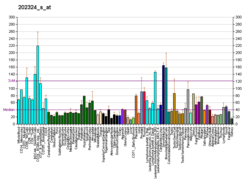ACBD3
Golgi resident protein GCP60 is a protein that in humans is encoded by the ACBD3 gene.[5]
Function
The Golgi complex plays a key role in the sorting and modification of proteins exported from the endoplasmic reticulum. ACBD3 is involved in maintaining the Golgi structure by interacting with giantin, which affects the transport of protein.[6] The protein encoded by this gene is involved in the maintenance of Golgi structure and function through its interaction with the integral membrane protein giantin. It may also be involved in the hormonal regulation of steroid formation.[5]
Interactions
ACBD3 has been shown to interact with GOLGB1.[7]
gollark: Um, can someone help debug?
gollark: I have no clue why, but despite working fine in the JS version, the Lua version completely refuses to work with skynet.
gollark: Er, reload...
gollark: Well, it's done, now to reboot the server...
gollark: But don't actually commit the changes for a few minutes because I'm just compiling skynet in release mode.
References
- GRCh38: Ensembl release 89: ENSG00000182827 - Ensembl, May 2017
- GRCm38: Ensembl release 89: ENSMUSG00000026499 - Ensembl, May 2017
- "Human PubMed Reference:". National Center for Biotechnology Information, U.S. National Library of Medicine.
- "Mouse PubMed Reference:". National Center for Biotechnology Information, U.S. National Library of Medicine.
- "Entrez Gene: ACBD3 acyl-Coenzyme A binding domain containing 3".
- "ACBD3 - Golgi resident protein GCP60 - Homo sapiens (Human) - ACBD3 gene & protein".
- Sohda M, Misumi Y, Yamamoto A, Yano A, Nakamura N, Ikehara Y (November 2001). "Identification and characterization of a novel Golgi protein, GCP60, that interacts with the integral membrane protein giantin". J. Biol. Chem. 276 (48): 45298–306. doi:10.1074/jbc.M108961200. PMID 11590181.
External links
- Human ACBD3 genome location and ACBD3 gene details page in the UCSC Genome Browser.
Further reading
- Sohda M, Misumi Y, Yamamoto A, Yano A, Nakamura N, Ikehara Y (2002). "Identification and characterization of a novel Golgi protein, GCP60, that interacts with the integral membrane protein giantin". J. Biol. Chem. 276 (48): 45298–306. doi:10.1074/jbc.M108961200. PMID 11590181.
- Li H, Degenhardt B, Tobin D, Yao ZX, Tasken K, Papadopoulos V (2002). "Identification, localization, and function in steroidogenesis of PAP7: a peripheral-type benzodiazepine receptor- and PKA (RIalpha)-associated protein". Mol. Endocrinol. 15 (12): 2211–28. doi:10.1210/me.15.12.2211. PMID 11731621.
- Gevaert K, Goethals M, Martens L, Van Damme J, Staes A, Thomas GR, Vandekerckhove J (2004). "Exploring proteomes and analyzing protein processing by mass spectrometric identification of sorted N-terminal peptides". Nat. Biotechnol. 21 (5): 566–9. doi:10.1038/nbt810. PMID 12665801.
- Liu J, Matyakhina L, Han Z, Sandrini F, Bei T, Stratakis CA, Papadopoulos V (2003). "Molecular cloning, chromosomal localization of human peripheral-type benzodiazepine receptor and PKA regulatory subunit type 1A (PRKAR1A)-associated protein PAP7, and studies in PRKAR1A mutant cells and tissues". FASEB J. 17 (9): 1189–91. doi:10.1096/fj.02-1066fje. PMID 12692076.
- Colland F, Jacq X, Trouplin V, Mougin C, Groizeleau C, Hamburger A, Meil A, Wojcik J, Legrain P, Gauthier JM (2004). "Functional Proteomics Mapping of a Human Signaling Pathway". Genome Res. 14 (7): 1324–32. doi:10.1101/gr.2334104. PMC 442148. PMID 15231748.
- Sbodio JI, Hicks SW, Simon D, Machamer CE (2006). "GCP60 preferentially interacts with a caspase-generated golgin-160 fragment". J. Biol. Chem. 281 (38): 27924–31. doi:10.1074/jbc.M603276200. PMID 16870622.
- Sbodio JI, Machamer CE (2007). "Identification of a redox-sensitive cysteine in GCP60 that regulates its interaction with golgin-160". J. Biol. Chem. 282 (41): 29874–81. doi:10.1074/jbc.M705794200. PMID 17711851.
This article is issued from Wikipedia. The text is licensed under Creative Commons - Attribution - Sharealike. Additional terms may apply for the media files.




